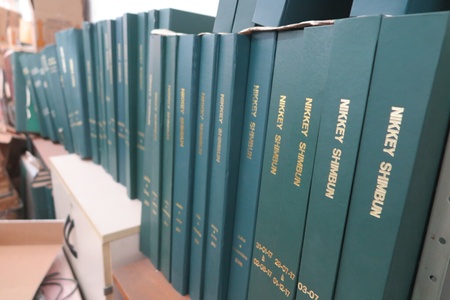A second-generation CEO who pioneered the Portuguese-language newspaper market
When it comes to the domestic Brazilian market, the key to a newspaper's survival is revitalizing its Portuguese-language pages.
The first Portuguese language magazine, Revista Arigatô, created by Paulista Newspaper (then president Paulo Ogawa), ceased publication in 1987. It was a groundbreaking initiative at the time, but it was not profitable.
Meanwhile, the Nihon- Brazilian Daily Newspaper (Nihon-Brazilian Daily Newspaper) began publishing a Portuguese supplement, Página Um, in its Saturday edition in April 1979. Led by the editor-in-chief of the Nihon-Brazilian Daily Portuguese Editorial Department, Kimura William, the zeroth issue was published in April 1979, inserted into the Saturday edition.
At the time, the Portuguese language section of a Japanese-language newspaper was considered a bonus of just one or two pages, so a separate volume entirely in Portuguese was a first attempt.
The tone was completely different from that of the Japanese paper, and it strongly reflected the sense of the times that the second generation had, such as the atmosphere of the times in general society, such as the movement away from military rule.
While the Paulista Shimbun produced a Portuguese-language page shortly after its founding, and the Nichimaichi Shimbun focused on producing a Portuguese-language supplement, the São Paulo Shimbun maintained a policy of not even producing a Portuguese-language page until around the 1960s, and continued to emphasize only the Japanese language until the very end.
Mizumoto Eduardo of the São Paulo Shimbun newspaper, when he was president, said in 1985, "We do not produce a newspaper for the entire community. We produce a newspaper for the Japanese, who make up 95 percent of our subscriber list, and those of Japanese descent are a bare minimum. So it makes no sense to radically change our newspaper to suit them. It is not realistic."
In other words, the São Paulo Shimbun newspaper's thinking was that the readers of its Japanese language paper were Japanese immigrants, and it rejected the idea of expanding its readership to include the Portuguese-speaking generation. This is why it has not put much effort into its Portuguese-language pages.
In this respect, Nikkei Shimbun is not just a supplementary edition, but has launched a Portuguese-language newspaper called "Jornal Nippak" that continues to this day. This is probably where President Raul's "sense of entrepreneurship as a second-generation entrepreneur" from the beginning comes from.
American professor who predicted the extinction of colonias 40 years ago
Takuji Fujii, who was the secretary-general of the Bunkyo Association, contributed an article to the inaugural issue of Weekly Jiho in 1976 entitled "We have high hopes for this brilliant pen."
He jokingly said, "Professor Smith of Cornell University in the United States, who came to Brazil a dozen years ago to investigate the integration of Japanese immigrants into Brazilian society, concluded that 'in 20 years' time, there will no longer be Japanese-language newspapers, Japanese-language schools, Buddhism, or new religions.'"
If Professor Smith's prediction was correct, Japanese-language newspapers would have disappeared in the 1980s. However, the fact is that they continue to exist as of 2021, some 40 years later. This means that the community itself continues to exist.
Fujii further wrote, "If asked, 'What is a colony?' I would immediately answer, 'Newspapers.' This is because I believe that if newspapers disappeared, the colony would fall apart. If there had been Japanese newspapers during the war, those winner-loser incidents would not have occurred. In the same way, if asked, 'How long will the Japanese language last?' I have no choice but to answer, 'It will share the same fate as the Japanese newspapers.' It's not a precise answer, but that's how important the position of newspapers is."
According to Fujii's theory, Japanese-language newspapers will continue as long as the Japanese-speaking community remains, and as long as the second and third generation immigrants maintain the Portuguese-speaking community, Portuguese-language newspapers will also continue.
Whether or not there is a "community paper" may be one barometer for measuring whether the Japanese community is still operating.
Since 2000, Japanese newspapers have also entered the internet era
As for the survival of Japanese-language newspapers, with the number of immigrant readers in Brazil declining, the new readership that should be cultivated would be Japanese people living outside Brazil, such as Japanese people in Japan.
In this regard, the Nikkei Shimbun has adapted to the times by adapting to the Internet.
The site was launched in 2001, and began publishing a PDF version in 2012. Currently, they offer a Web membership that allows users to view both paid articles and PDF versions of the site, as well as group accounts for companies and schools. Group accounts include those for Waseda University and Kanda University of International Studies.
In addition, the domestic subscribers identified by the Tokyo branch (Branch Manager Koshiishi Nobuo) include not only major financial institutions and investment institutions such as the Bank of Japan, but also many companies expanding into and investing in Brazil, research institutes such as ◎◎ Research Institute, famous universities, and various government departments.
Due to the company's contract with Yahoo! News to publish articles, its articles are now more often read online than in print form.
Among them, the article "Brazilian journalist's column " Brazilians in Japan should also receive 100,000 yen " posted on Yahoo! News on April 18, 2020, recorded 1.95 million views. Opinions were exchanged in the comments section, both for and against, raising major issues.
The phenomenon of an article in a Japanese language newspaper reaching nearly 2 million people in Japan is something that is unique to the Internet age. On Yahoo! News, there have been nearly 10 articles with hundreds of thousands of views this year alone.
An article on our website dated April 27, 2019 entitled “ Fifth-generation Japanese-American high school student gives impressive congratulatory speech at ceremony marking 30 years since the Emperor’s accession to the throne, standing alongside Director Kitano, Professor Yamanaka and others ” received 2,500 likes, proving that some articles are being read by many Japanese people as well.
In this way, the magazine is playing a stronger role as a medium that disseminates information about Brazil not only to immigrant readers in Brazil, but also to Japanese readers in Japan. This trend has become particularly noticeable since the pandemic.
It would be a waste to just throw away what we have cultivated so far. I want to make it my task for the next generation to further develop this area.
© 2021 Masayuki Fukasawa / Nikkey Shinbun







